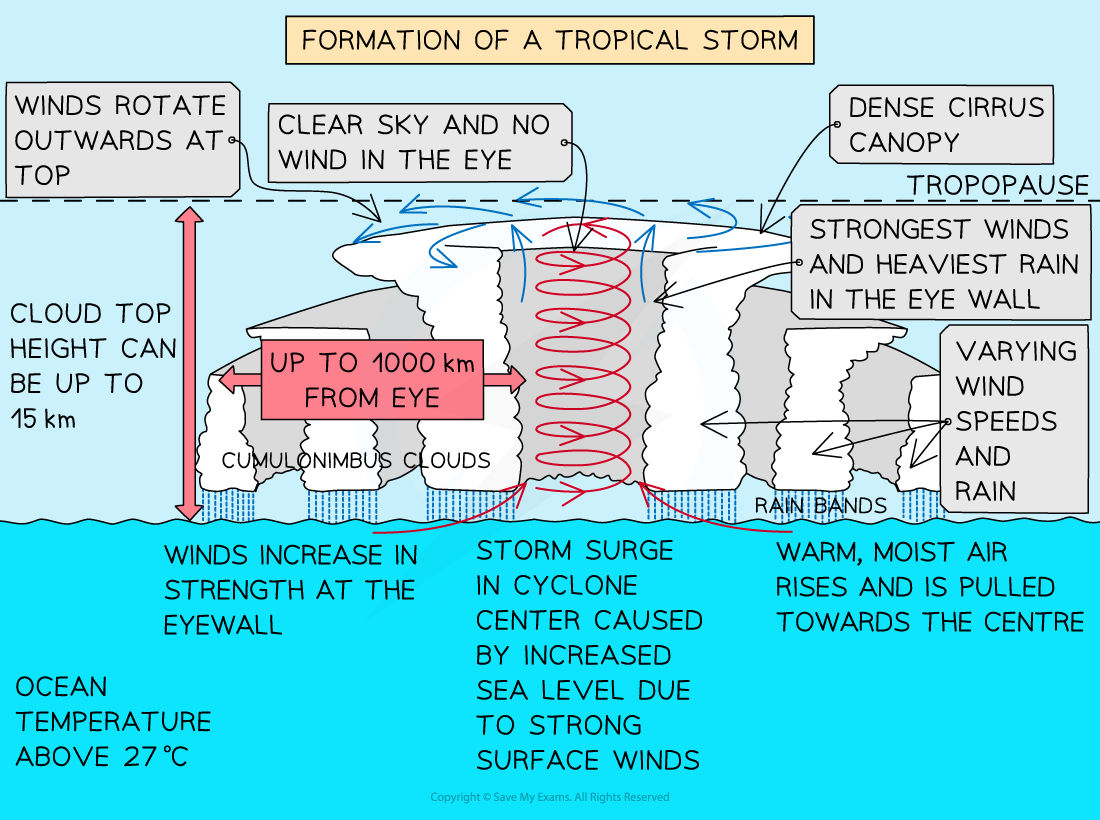Distribution & Frequency of Tropical Storms
- The distribution of tropical storms is consistent, however, their frequency varies
- Tropical storms are rotating, intense low-pressure systems (below 950mb)
- They are also known as:
- Typhoons in the South China Sea and west Pacific Ocean
- Hurricanes in the Gulf of Mexico, Caribbean Sea and west coast of Mexico
- Cyclones in the Bay of Bengal, Indian Ocean and northern Australia
- Depending on their wind speed, they are bas:
- Tropical depression - wind speeds of less than 62 km/h (38 mph)
- Tropical storm - wind speeds ranging from 63 - 118 km/h (39 - 73 mph)
- Tropical cyclone with wind speeds above 119 km/h (74 mph)
Map Showing the Global Distribution of Tropical Storms

Distribution
- They develop over the warm tropical oceans usually between 5° and 15° north and south of the equator, although they can extend to as high as 30°
- Ocean temperatures must be in excess of 27°C and to a depth of 50-60 metres
- At least 500 km from the equator in order for the Coriolis force/effect to spin the tropical storm
Frequency
- Depends on where and which hemisphere, but on average over 80 tropical storms are generated by tropical oceans every year
- Tropical storms begin when tropical oceans are at their warmest, which is usually late summer (Nov-April southern hemisphere and June-Nov northern hemisphere)
- The Pacific Ocean sees the largest number of tropical storms, followed by the Indian Ocean, and lastly the Atlantic
- Tropical storms in the western Pacific are the strongest
Average Frequency of Tropical Storms
| Place | Months | Frequency / Average |
| South Atlantic | August - October | 9+ |
| North-east Pacific | June - October | 13+ |
| North-west Pacific | June - December | 26+ |
| North Indian Ocean | June - November | 2 |
| Bay of Bengal | June - November | 6+ |
| South-west Indian Ocean | January - March | 9+ |
| South Pacific | January - March | 7+ |
Changes in frequency
- Although the number of Atlantic storms has increased, the overall global frequency remains steady
- However, tropical storm intensity has increased by 70% over the last 30 years
- El Niño cycles increase wind strength high over the Atlantic, which has the effect of decreasing storm activity overall (winds are too strong and will tear through developing storms above the ocean surface)
- Global warming has the potential of increasing the frequency, distribution and intensity of tropical storms in the future
Exam Tip
Make sure you know facts and figure on the distribution and frequency of tropical storms. As warming of our oceans continue, it is probable that tropical storms will be seen at higher latitudes than in the past. This is because there will be more energy available for storms to travel further.





